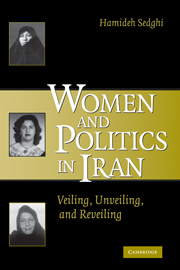Book contents
- Frontmatter
- Contents
- Acknowledgments
- Transliteration and References
- Introduction
- PART I WOMEN IN EARLY TWENTIETH-CENTURY IRAN
- PART II WOMEN IN THE KINGDOM OF THE PEACOCK THRONE
- 2 The Pahlavi Dynasty as a Centralizing Patriarchy
- 3 Economic Development and the Gender Division of Labor
- 4 The State and Gender: Repression, Reform, and Family Legislation
- 5 Women and the State
- PART III WOMEN IN THE ISLAMIC REPUBLIC OF IRAN
- Conclusion
- Glossary
- Selected Bibliography
- Index
3 - Economic Development and the Gender Division of Labor
from PART II - WOMEN IN THE KINGDOM OF THE PEACOCK THRONE
Published online by Cambridge University Press: 22 August 2009
- Frontmatter
- Contents
- Acknowledgments
- Transliteration and References
- Introduction
- PART I WOMEN IN EARLY TWENTIETH-CENTURY IRAN
- PART II WOMEN IN THE KINGDOM OF THE PEACOCK THRONE
- 2 The Pahlavi Dynasty as a Centralizing Patriarchy
- 3 Economic Development and the Gender Division of Labor
- 4 The State and Gender: Repression, Reform, and Family Legislation
- 5 Women and the State
- PART III WOMEN IN THE ISLAMIC REPUBLIC OF IRAN
- Conclusion
- Glossary
- Selected Bibliography
- Index
Summary
“Since American military and other aid has brought my country such important direct and indirect benefits,” declared Mohammad Reza Shah in an autobiography written a few years after the CIA returned him to the throne, “I hope I shall not sound ungrateful if I state my conviction that we have been receiving glaringly inadequate amounts of it.” In fact, the Cold War brought American military and economic aid to Iran by the late 1950s, helping the Shah consolidate his power against communism and the secular and religious opposition. He expressed his own preeminence in a 1973 interview with Oriana Fallaci: “Where there's no monarchy, there is anarchy, or an oligarchy or a dictatorship.”
Iran's integration into the world market and the ensuing economic growth based on rising oil revenues bolstered the state's power. Unleashing the unpredictable forces of change and expediently defending the throne with either co-optation or repression, the state launched several projects that changed the structure of the economy, the labor force, and the gender division of labor. Urban communities expanded with migration from rural areas, and the enlarging industrial and service sectors absorbed even more workers. More women, unveiled and educated, followed Western fashions and joined the growing labor market. Many began working in gender mixed occupations, while experienced the “double day,” working both inside and outside the home.
- Type
- Chapter
- Information
- Women and Politics in IranVeiling, Unveiling, and Reveiling, pp. 99 - 127Publisher: Cambridge University PressPrint publication year: 2007



